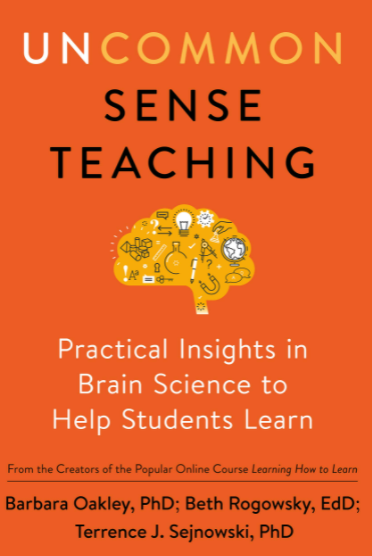5 Teaching Tips Using Brain Science
Teaching tips using brain science from Beth Rogowsky, a professor at Bloomsburg University, from her book on brain science and teaching.

Understanding brain science can help you improve teaching practice and make sure you are following the science of teaching best practices.
As a college professor and science writer, I’ve long been fascinated by learning more about how the human brain works and how I can help students of various abilities learn better and more efficiently. One great tool for doing this has been reading Uncommon Sense Teaching: Practical Insights in Brain Science to Help Students Learn, a book that simplifies complex brain/cognitive science concepts into easy-to-implement classroom best practices.
Beth Rogowsky, an associate professor at Bloomsburg University and former K-12 English teacher, co-authored this book with Barbara Oakley and Terrence Sejnowski. I spoke with Rogowsky about the book, and she shares advice on prioritizing active learning in a way that doesn’t just keep students busy but increases their learning. She also discusses the difference between long-term and short-term memory and how we can prioritize building long-term memory in our students, as well as how to create strategies that help and challenge fast and slow learners in various subjects.
Here are her easy-to-implement brain science tips.
1. Recognize Some Students Struggle with Working Memory
Two of the most important types of memory for the classroom setting are working and long-term memory. Information in working memory can fade within moments while long-term memory is much more persistent, sometimes lasting a lifetime. Often students cannot store as much information as their teacher gives them in working memory so they get confused about even how to start an assignment. To support all students regardless of their working memory abilities, Rogowsky and her co-authors advise the following:
- Be brief and linguistically simple as possible when giving directions.
- Make sure your students are looking at you when you are giving directions. (They write, using the phrase “Please turn so you can see me,” can be surprisingly helpful.)
- Give instructions one at a time and include a “step check” to make sure all students are with you. (One example of a “step check” would be to have students look over their desk partners' work and say “Well done!” if the step is completed. If not, the teacher can offer assistance.)
- Use mnemonics (memory tricks) to help students recall larger pieces of information.
- Supply spellings of unfamiliar or challenging words to students as they respond to writing prompts.
2. Help Students Transfer Lessons to Long-Term Memory

Once students overcome challenges with working memory, the next step is forming long-term memories around class materials. “Students use their notes so much for things, or they do a Google search for things,” Rogowsky says. “The problem with that is they're not getting the information in long-term memory. And so when they go home and try to do the homework problems, they can't.”
She adds, “When you look at it from a neuroscientific perspective, information is coming in and going right to working memory. And working memory is pretty good, but it can only handle two to five pieces of information, and then it falls apart.”
Tools and ideas to transform education. Sign up below.
That’s why allowing students time to move new information from working memory to long-term memory by providing them with lots of opportunities to practice is important. “If teachers just keep giving more and more information, the students lose it, and then they tune out,” Rogowsky says. “So having those ‘Think-Pair-Shares,’ having time to stop and look at your notes and ask questions, that is so essential to instruction.”
3. Recognize Students Learn at Different Speeds
To emphasize the different speeds at which learning can occur, Rogowsky and her co-authors compare students to either racecars or hikers. Racecar students will get to the finish line fast, while hikers will also eventually get there but need more time. “We are all hikers and racecars; it just depends on the subject matter and the topic within the subject matter, our prior knowledge, and our working memory capacity,” Rogowsky says. “You want me to do statistics? I am the biggest hiker in the world.”
Recognizing this distinction means setting up your classroom activities to support hiker and racecar learners in your class. Hikers will need more time and support to learn the main lesson, while teachers should also plan and provide extension activities for racecars so they are continually challenged by the material, Rogowsky says.
4. Lecture Less
“Lecture is very passive,” Rogowsky says. “Just being conscious of stopping every so often, and giving students time to practice and understand, allows the hippocampus to offload [information] and help get it into long-term memory.”
Technology can help keep students active and engaged during these short breaks in direct instruction. Rogowsky suggests using tools such as Quizlet and having students write a one-sentence summary of what their teacher just said or students can pair up and correct each other’s work.
Rogowsky recommends the “I do – we do – you do model.” For this model, first she suggests teachers start with a 7-15 minute session of direct instruction (with pauses for students to catch up and reflect). Second, teachers should give students time to practice the lesson with assistance. Third, students are able to present or apply the lesson without the teacher's assistance.
5. Be Careful How Some Educational Advice is Implemented
There are many popular theories about education but not all of them are backed by science. “For too long, the field of education was just about theory,” Rogowsky says.
Even today, theories such as each child having a unique learning style persist despite being debunked repeatedly, Rogowsky says. In addition, although she’s a proponent of active learning, she says sometimes it gets implemented in non-productive ways. “Be careful of the lore of the idea of ‘hands-on equals minds-on’,” she says. “That ends up being a lot of cutting and pasting, or spending days and days putting bells and whistles on PowerPoint presentation.”
Although these types of projects might entertain students, they don’t always teach them core lessons. “Arts and crafts are not teaching the essential content that we need to be teaching, and that's not what active learning is all about,” she says. “Active learning is that play between working memory, the hippocampus, and long-term memory.”
- Audiobooks for Students: Listening to What the Research Says
- Active Learning: 5 Tips for Implementing the Approach
- Why Traditional Lectures Won’t End Anytime Soon in Higher Ed Despite Better Approaches Being Available
This article was updated in August 2023
Erik Ofgang is a Tech & Learning contributor. A journalist, author and educator, his work has appeared in The New York Times, the Washington Post, the Smithsonian, The Atlantic, and Associated Press. He currently teaches at Western Connecticut State University’s MFA program. While a staff writer at Connecticut Magazine he won a Society of Professional Journalism Award for his education reporting. He is interested in how humans learn and how technology can make that more effective.

